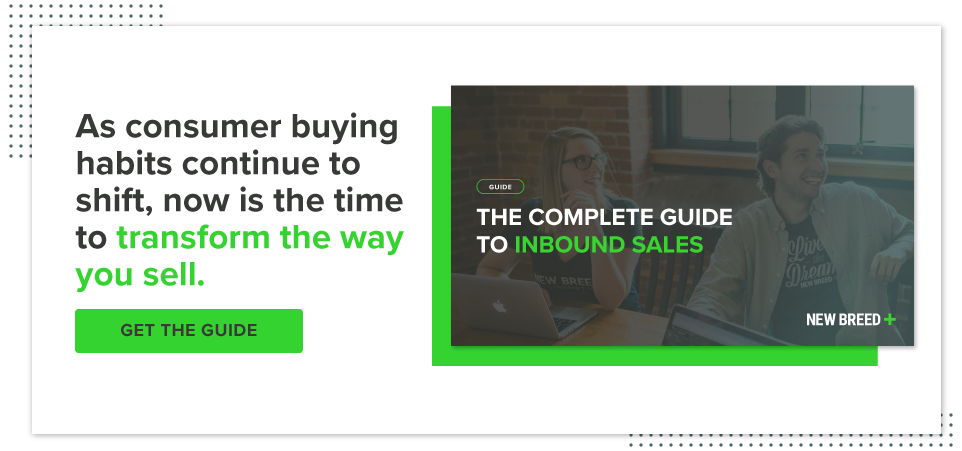Traditional sales processes are seller-centric. They can be intrusive and focus on reaching out to potential customers regardless of whether they’ve expressed interest in the product or service being sold.
An inbound sales process is a buyer-centric way of selling that adds value and focuses on solving for a prospect’s needs when and where they need it.
Instead of reaching out to anyone who could be a good-fit customer, inbound sales starts by looking at leads who have displayed an interest in your company. Here’s a look at the steps of the inbound sales process:
Identify and Qualify
While inbound sales starts with leads who’ve voluntarily shown interest in your company, that doesn't mean that those leads are actually a good fit for your solution. Because of that, an important first step of the sales process is to qualify each prospect and get a sense of whether they can benefit from your offering.
Not everyone who comes through your website is going to be a good fit for you, so you need to be able to qualify, enrich and understand who the prospect is.
- Do they align with one of your buyer personas?
- What company do they work at?
- Does their company align with one of your ICPs?
- Are they a decision-maker within their company?

Connect and Engage
Once you’ve determined qualification, the next step is to start engaging with the good-fit prospects.
To do this effectively, you need to understand digital body language. How do you determine the different levels of interest from the leads coming in? How do you use that knowledge to prioritize prospects?
If one qualified lead is a regular blog subscriber, another has downloaded four checklists in the past two days and a third submitted a form to get in touch with sales, you’ll need to treat each of those leads differently.
Your sales outreach and approach should mimic the level of interest and engagement each prospect displays. If you’re reaching out to everyone with the same templated messages at the same cadence, that’s not inbound sales, and it’s not an effective sales strategy.
As you’re preparing to connect with a prospect do some additional research to understand what’s valuable for each lead. While at this stage you might not be doing 1-to-1 outreach yet because of the large number of leads you’re connecting with, you should be creating much more specific segments than a marketer would and center your messaging around an action they took or an interest they showed.
In order to successfully connect with a prospect, you also need to make sure that you’re always providing value. When training New Breed’s team, I always emphasize that every message should have a “give” and a “get” and that it’s essential to add value for a prospect before asking for something from them.
Advise and Solve
As you move further into the sales process, you need to keep the mindset “always be helping” as opposed to “always be closing.”
I like to use the analogy of sales reps being like a sherpa. You need to lead your prospect up the mountain at a pace that works for them and solve all the things that come up along the way to the top. Take the context clues you’ve received from the prospect and advise them about how to best solve for their problems.
You will have more success through an inbound sales model if you keep the focus on the buyer instead of yourself. Structuring your sales process around buyers and incentivizing your reps to behave that way will help you develop a culture of inbound sales success.
If you advise a prospect properly and provide the right solution set that meets their needs and accommodates their resource constraints then you won’t have a problem closing the deal.
That being said, part of advising at the end of a sales process can involve holding your prospect accountable if they start to stall. Remind them why they came to you in the first place and what the positive implications and negative consequences of their decision.
Pass on Information
A client’s experience with a company begins with sales; the sales process and service delivery shouldn’t feel like two disparate experiences for the customer. For that to happen, the handoff from sales to service needs to feel like a seamless motion.
When a deal closes, sales reps need to arm the services team with all the information that was collected throughout the inbound sales process. That can involve making sure all teams are using the same CRM and contact records are kept up to date, sales sharing call recordings with service team members and making sure all relevant documents are accessible for everyone who’ll work with that customer.
The Takeaway
After every deal, whether it was closed-won or closed-lost, sales reps should do a post-mortem reflecting on how the sales process played out.
Consider all the steps that were taken and how the prospect responded at every stage. What could have been done better? What worked really well that can be replicated in the future? How do successful sales processes differ from unsuccessful ones?
Since the inbound sales process is buyer-centric, it’s not going to look the same for every deal. Reflecting on the contributing factors of your successes and failures can help you adapt your process to the needs of your prospects.
Beth Abbott
Beth is a Senior Manager of Revenue Operations at New Breed and specializes in optimizing how processes and platforms support revenue growth.




